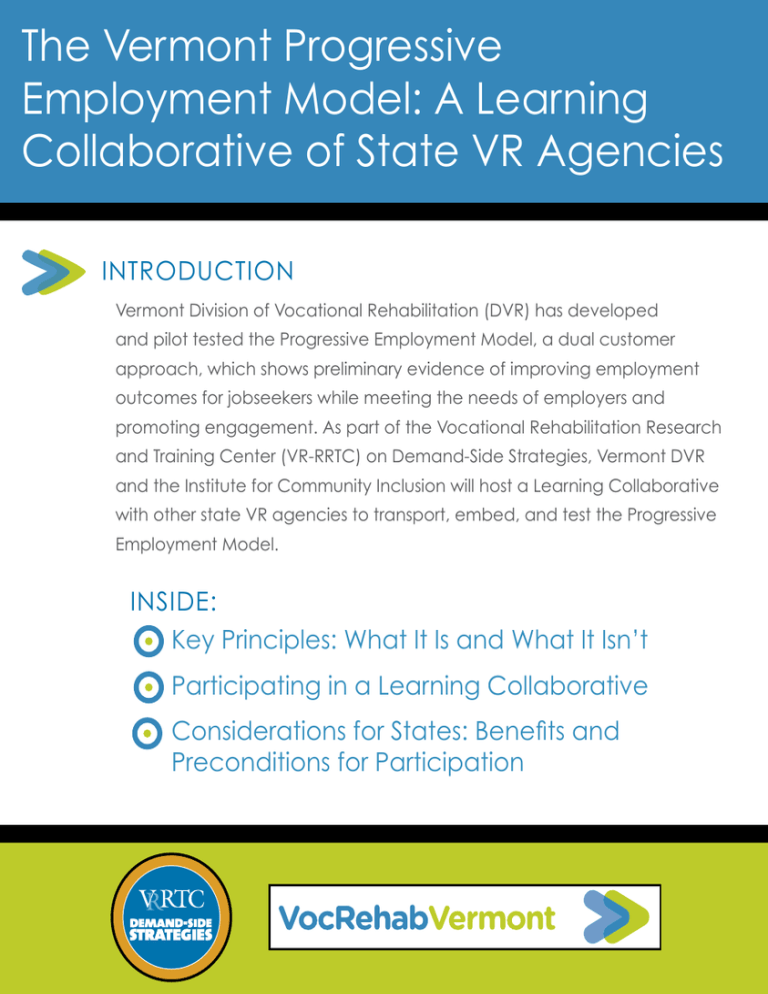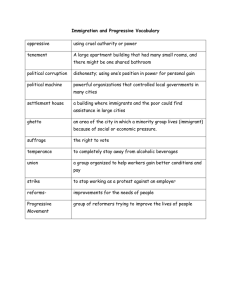The Vermont Progressive Employment Model: A - VR-RRTC
advertisement

The Vermont Progressive Employment Model: A Learning Collaborative of State VR Agencies Introduction Vermont Division of Vocational Rehabilitation (DVR) has developed and pilot tested the Progressive Employment Model, a dual customer approach, which shows preliminary evidence of improving employment outcomes for jobseekers while meeting the needs of employers and promoting engagement. As part of the Vocational Rehabilitation Research and Training Center (VR-RRTC) on Demand-Side Strategies, Vermont DVR and the Institute for Community Inclusion will host a Learning Collaborative with other state VR agencies to transport, embed, and test the Progressive Employment Model. Inside: Key Principles: What It Is and What It Isn’t Participating in a Learning Collaborative Considerations for States: Benefits and Preconditions for Participation Key Principles: What It Is and What It Isn’t Progressive Employment is an employment strategy that provides individuals who have little or no work history, low skill levels, corrections involvement, or other barriers a way into paid employment that builds momentum and provides a means to increase Ke y P ri n ciples: W hat I t I s a nd Wh at It Isn’ t skill level and confidence. The key principles are: Everyone is ready for something Small success leads to further success Progressive Employment provides flexibility and creativity based on each person’s or employer’s situation It is low risk for both the employer and the participant Progressive Employment is an engagement strategy and eliminates the need to be “job ready” Progressive employment is: A series of placement options geared to the skill level of the individual, e.g. company tour, job shadow, short-term work experience A method to evaluate existing work skills, reduce fear and identify training, support or accommodation needs A way to develop interpersonal and customer service skills An opportunity for individuals to explore possible careers in short-term placements A way to introduce a candidate to a prospective employer A tool to build a resume and professional references Negotiated by employment staff directly with the employer A way for employment staff to “offer” a variety of options for an employer rather than “ask” for consideration of their customers for open positions A proven method to increase employers’ understanding of disabilities Progressive employment is not: A promise of employment Providing a wage unless the employer places the person on their payroll through an On-the-Job Training option Long-term subsidized employment or “warehousing” A violation of the Fair Labor Standard Act Full time employment The only option – those who have skills and experience are placed directly into competitive employment whenever possible Participating in a Learning Collaborative In collaboration with the Institute for Community Inclusion and the VR-RRTC on Demand-Side Strategies, Vermont Division of Vocational Rehabilitation is adopting and adapting a learning collaborative method used in other fields solving, identification and application of practice based solutions, and evaluation of related outcomes. Anticipated benefits include identification of workable solutions, space to innovate, new colleagues in other state VR agencies, use of critical skills, professional development opportunities, and the opportunity to pilot an effort before going to scale. State VR Agencies are asked to: Identify a lead person and a team with designated roles Participate in face-to-face meetings, on-site consultation, and distance consultation Complete a pre- and post- self assessment Identify, launch, and complete a Progressive Employment initiative Participate in the design and conduct of evaluation activities Act as peer consultants to other members of the learning collaborative Vermont DVR and the ICI will: Host, organize and pay for learning collaborative meetings, webinars, phone conferences and similar communication strategies Identify and pay for external consultants and experts on key topics identified by the learning collaborative members Provide consultation and coaching on evaluation strategies Participating in a L ear n i n g C olla bo rative (notably public health) to initiate a cross VR agency strategy for problem Benefits to Participating State VR Agencies Considerations and Preconditions for State VR Agencies Will receive staff training and support to implement Progressive Employment Must have or be able to develop Liability and Workers’ Comp insurances for trainees Will be part of a learning collaborative to explore best practices Must have employment staff who are able to negotiate directly with employers Will increase employer participation and engagement Must demonstrate some communication and coordination between employment staff and VR Counselors Will increase employment opportunities for customers and thus better outcomes Will increase labor market understanding Will increase collaboration between employment staff and counseling staff Provides counseling and employment staff an assessment tool to gauge skill level and training needs for job seekers contact information Hugh Bradshaw Vermont Division of Vocational Rehabilitation (802) 871-3054 hugh.bradshaw@state.vt.us www.vr-rrtc.org/demandside Must understand current federal and state labor laws Must have or be able to develop a mechanism for set asides or method for providing training offset funds for participants and training funds to employers Must have or be able to develop a tracking tool for data collection Must define parameters for involvement of contracted Community Rehabilitation Providers (CRPs) Benefits and Preconditions for Participation Considerations for States: Benefits and Preconditions for Participation The VR-RRTC on Demand-Side Strategies is a project of the Institute for Community Inclusion at UMass Boston, funded by NIDRR grant #H133B120002


